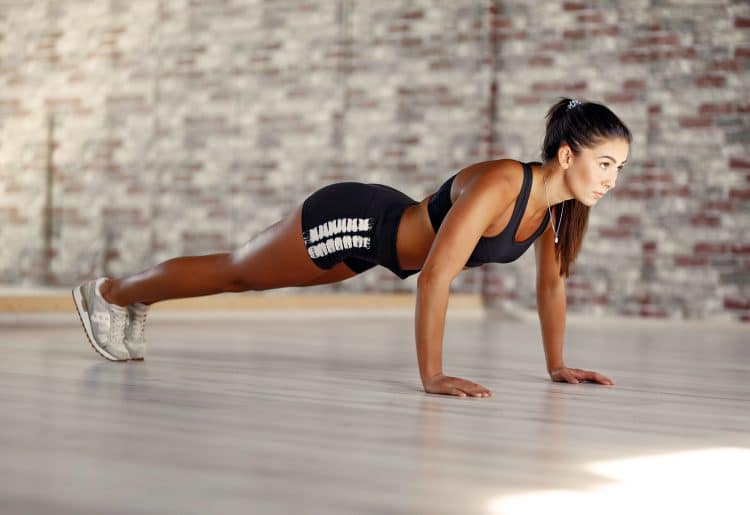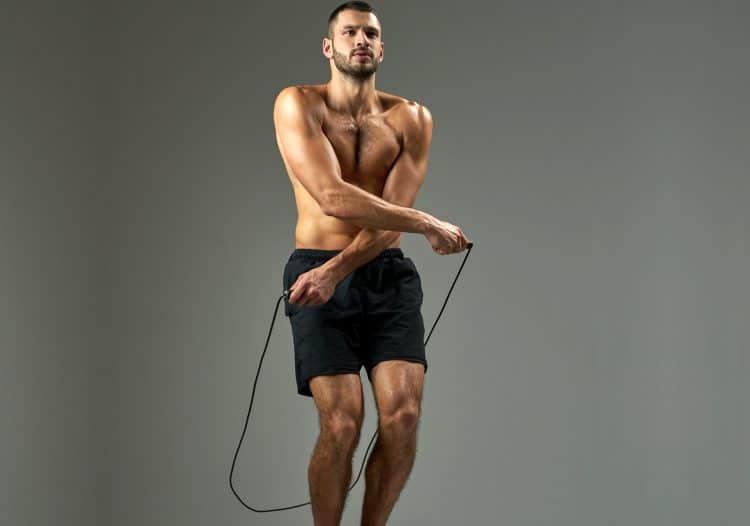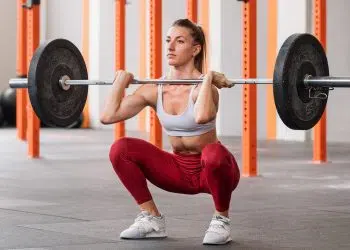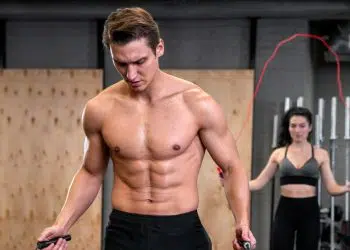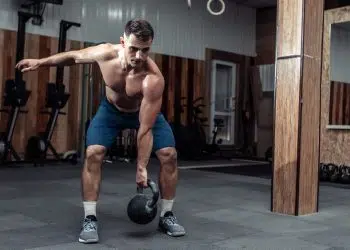It was my first athletics coach who introduced me to the joys of circuit training. As a young long and triple jumper, he put me through many hours of circuit training to build my endurance, strength, and power and improve my conditioning.
While these workouts were always tough, they were also enjoyable and rewarding. They were a big part of my athletic success.
Fast forward over 30 years, and I’m still a massive fan of circuit training. As a veteran personal trainer, I frequently incorporate circuits into my clients’ training and use them in my own workouts, too.
That’s because, in terms of time efficiency and bang for your buck, circuit training is hard to beat. And that’s not just my opinion; numerous studies support the use of circuit training for building strength and fitness. (1).
While circuit training is good for everybody’s body, athletes will get the best results by programming their workouts according to their specific needs and goals.
In this article, I use my experience as an athlete and coach to show you how to integrate circuit training into your strength and conditioning workouts.
Level Up Your Fitness: Join our 💪 strong community in Fitness Volt Newsletter. Get daily inspiration, expert-backed workouts, nutrition tips, the latest in strength sports, and the support you need to reach your goals. Subscribe for free!
Circuit Training Basics
Before we get into the nitty-gritty of circuit training for athletes, let’s take a moment to discuss the basics of circuit training so we’re all on the same page. After all, even traditional training methods like circuit training can mean different things to different people.
What is Circuit Training?
Circuit training has probably been around since the times of ancient Rome and Greece. However, it was first extensively researched in the early 1950s at Leeds University in England by R.E. Morgan and G.T. Anderson (2).
A circuit training workout involves doing several exercises back-to-back with little or no rest in between. Exercises are called stations, and there are usually 6-12 in a circuit training workout.
Each station is done for time or repetitions and can involve any type of equipment, including barbells, machines, dumbbells, medicine balls, or bodyweight exercises.
In most cases, participants do multiple rounds of each circuit, typically 2-5, resting for 1-3 minutes between each round.
Circuits can be thematic, i.e., designed to develop a specific type of fitness or ability, e.g., agility, power, or strength. Alternatively, they can be general conditioning circuits designed to improve fitness and endurance.
Related: What is Circuit Training? The Ultimate Guide to Get Lean
Here’s an example general fitness circuit that demonstrates the basics of this training method:
Do 2-4 laps of the following stations. Move as quickly as possible between stations, and rest for 1-2 minutes between rounds.
| No. | Exercise | Repetitions |
|---|---|---|
| 1 | Pull-ups | 10 |
| 2 | Rear foot elevated split squats | 15 per leg |
| 3 | Push-ups | 15 |
| 4 | Banded good mornings | 20 |
| 5 | Abs wheel rollout | 15 |
| 6 | Single-arm dumbbell row | 15 |
| 7 | Air squats | 20 |
| 8 | Dumbbell shoulder press | 15 |
| 9 | Box jump | 15 |
| 10 | Hanging knees to chest | 15 |
Adjust the difficulty of the exercises, repetitions, and rest between rounds according to your abilities and needs.
Related: Circuit Training vs. HIIT For Fitness and Fat Loss
Circuit Training Benefits
So, do circuits deserve a place in your athletic training? Consider these benefits and then decide!
Time-efficient – circuit training is a non-stop workout where rests between exercises are kept to a minimum. This ensures you waste very little time recovering between stations and rounds. In many cases, you can get a comprehensive full-body workout in 30-40 minutes.
Sportspeople have to balance strength and conditioning training with skills work and practice. As such, circuit training is valuable for athletes
Easy to modify – you can adapt circuit training to meet any sports or fitness-related goal. Plus, you can easily change the workout variables to raise or lower the intensity level. This can often be done “on the fly,” i.e., during a workout in response to participant feedback.
Modifiable variables for circuit training include:
- Type of exercise
- Number of stations
- Repetitions/duration
- Number of rounds
- Rest between stations
- Rest between rounds
- Training frequency
With so many changeable elements, it’s easy to see how you can adapt circuit training to meet your needs and goals.
Train multiple fitness components simultaneously – some athletes are specialists and require only a high level of strength (e.g., powerlifters) or cardiovascular conditioning (e.g., marathon runners) to compete. In contrast, other athletes need all-around fitness as their sport has a wider set of demands, e.g., soccer, basketball, hockey, and football players.
Circuit training can target multiple fitness components simultaneously. As such, it can have a better carryover to some sports than training things like strength, power, and cardiovascular fitness separately.
Enjoyable and fun – while athletes often take their training more seriously than recreational exercisers, they still value enjoyment and fun. After all, even effective but boring workouts will soon lose their appeal.
Circuit training is so flexible that you don’t really have time to get bored. Also, with so many variables to manipulate, you don’t need to repeat a workout if you don’t want to. This increased enjoyment will go a long way to enhancing motivation.
Suitable for groups and teams – circuit training is perfect for group and team workouts. Whether you have one person per station or put athletes in pairs, the camaraderie and competitiveness of circuit training are hard to beat.
Types and Examples of Circuit Training Workouts for Athletes
Whatever your athletic training goal, you can probably use circuits to achieve it. After all, circuit training is very flexible and can be adapted to accomplish a wide range of outcomes. With that in mind, here are some sample workouts addressing common athletic objectives.
Level Up Your Fitness: Join our 💪 strong community in Fitness Volt Newsletter. Get daily inspiration, expert-backed workouts, nutrition tips, the latest in strength sports, and the support you need to reach your goals. Subscribe for free!
Feel free to adjust the exercises, reps/times, and rest periods according to your needs and goals.
Workout 1: Cardio/Endurance Circuit
This circuit will boost fitness and endurance for sport. Think of it as a non-specific conditioning circuit that’ll increase your work capacity. This workout will elevate your heart and breathing rate and leave you feeling gassed.
Do 3-5 rounds of the following exercises, moving as quickly as possible between stations. Perform each exercise for 45 seconds and rest for 1-2 minutes between rounds.
- Jump rope
- Burpees
- 10-yard shuttle sprints
- Alternating step-ups
- Jumping jacks
- Mountain climbers
- Jump rope (high knees)
- Lateral shuffles
Workout 2: Full Body Power Circuit
Power is force generated quickly and is a critical component of many sports. Examples of power activities include punching, kicking, throwing, jumping, and rapid direction changes. You should choose power exercises based on the main movements of your sport. As such, feel free to change these exercises to better suit your needs.
Do 3-5 rounds of the following exercises. Move quickly between stations, but don’t rush. Avoid being so out of breath that you cannot put maximum effort into each movement. Perform the specified number of reps for each exercise and rest for 1-2 minutes between rounds.
| No. | Exercise | Repetitions |
|---|---|---|
| 1 | Squat jump | 10 |
| 2 | Plyometric push-up | 10 |
| 3 | Medicine ball slam | 10 |
| 4 | Split squat jump | 5 per leg |
| 5 | Medicine ball rotational throw | 5 per side |
| 6 | Medicine ball overhead throw | 10 |
| 7 | Box jump | 10 |
| 8 | Medicine ball shot-putt throw | 5 per side |
Related: 10 Best Plyometric Exercises to Build Explosive Power
Workout 3: Prehab Circuit
Where rehabilitation exercises (rehab) are meant to help you recover from injury, prehab training aims to prevent injuries in the first place. In most cases, this is done by addressing common weak links, such as the rotator cuff, core, and hip stabilizers.
Unfortunately, while such training is valuable, it can also be boring, especially for athletes who are used to high-intensity workouts. Doing prehab exercises as a circuit is one way to make this type of training more appealing.
Do 3-5 rounds of the following exercises, moving as quickly as possible between stations. Work in the specified rep arranges and rest for 1-2 minutes between rounds.
| No. | Exercise | Repetitions/Duration |
|---|---|---|
| 1 | Resistance band 90/90 external shoulder rotations | 12-20 |
| 2 | Banded side steps | 12-20 |
| 3 | Dead bugs | 12-20 |
| 4 | Dumbbell Cuban press | 12-20 |
| 5 | Stability ball reverse hypers | 12-20 |
| 6 | Resistance band face pulls | 12-20 |
| 7 | Bird dogs | 12-20 per side |
| 8 | Clamshell external hip rotations | 12-20 per side |
| 9 | Resistance band external shoulder rotations | 12-20 per side |
| 10 | 1-leg balancing | 20-30 seconds per side |
Workout 4: Full Body Strength Circuit
Like power, strength is a critical component of many sports. However, strength training can be time-consuming because rests between sets are often very long. Organizing your strength exercises into a circuit makes much better use of your time as each exercise provides a rest from the one that preceded it.
Do 3-5 rounds of the following exercises, taking 30-60 seconds to move from one to the next. Work in the specified rep arranges and rest for 2-3 minutes between rounds.
| No. | Exercise | Repetitions |
|---|---|---|
| 1 | Deadlift | 4-6 |
| 2 | Bench press | 4-6 |
| 3 | Weighted pull-up | 4-6 |
| 4 | Squat | 4-6 |
| 5 | Overhead press | 4-6 |
| 6 | Pendlay row | 4-6 |
Workout 5: Speed, Agility and Quickness Circuit
Speed, agility, and quickness (SAQ) are critical components in many sports. The ability to sprint, dodge, duck, and dive is at least as important as general fitness and strength. You should choose SAQ exercises based on the movements of your sport. As such, feel free to change these exercises to better suit your needs.
Do 3-5 rounds of the following exercises. Move quickly between stations, but don’t rush. Avoid being so out of breath that you cannot put maximum effort into each movement. Perform each exercise for 30-40 seconds, resting for 2-3 minutes between rounds.
- Agility ladder quick feet
- Lateral two-footed hurdle jumps
- Step over-duck unders
- Reaction ball bounce and catch
- Lateral hurdle hops (left)
- Lateral hurdle hops (right)
- Agility ladder lateral run
- Clock lunges (left)
- Clock lunges (right)
- Tethered resistance band sprints
FAQ’s
Do you have a question about circuit training for athletes? No problem, because I’ve got the answers!
1. What is the best way to warm up for circuit training?
Any good workout starts with a thorough warm-up, and circuit training is no different. Follow these steps to make sure your muscles and joints are ready for what you’re about to do.
- Pulse raiser – 5-10 minutes of cardio
- Joint mobility exercises
- Dynamic flexibility exercises
- A few easy reps of each exercise in the upcoming circuit
Related: How to Warm Up for Strength Training
2. Do you have any advice for creating circuit workouts for athletes?
While circuit training can be a valuable tool for athletes, if you use it incorrectly, you could end up causing more harm than good. Here are a few things to consider when designing circuit training workouts:
Get specific – a circuit for runners should be different from one written for cyclists or swimmers. Make sure your workout matches the needs of your sport. Consider things like movement direction, effort intensity, typical load, duration of effort, etc., and make sure your circuit matches these demands.
Quality vs. quantity – understand that more is not always better for circuit training. Focus more on exercise and movement quality than quantity to avoid unnecessary fatigue. While you can do five laps of a circuit, two or three might provide a better balance between work and recovery.
Start easy, progress gradually – like all forms of effective training, circuit workouts must be progressive to be effective. Make sure you leave room to increase the intensity and duration of your workouts to keep driving your fitness forward.
Emphasize compound exercises – while you can include single-joint isolation exercises in your circuits, you’ll get more bang for your buck if you focus on compound movements. As well as being more time-efficient, compound exercises are more likely to match the movement demands of your chosen sport.
Use rest/transition periods strategically – circuit training workouts typically involve little or no rest between stations. This enhances time efficiency and conditioning. However, you should avoid rushing from one exercise to the next, as doing so could harm overall performance. Sometimes, a longer transition, e.g., 20-30 seconds, may be better.
Remember that rest periods are one of the things you can modify to alter the effect of your workout.
3. Is circuit training safe?
No workout is 100% safe, and there is always a small risk of injury. However, provided you warm up properly, use good exercise technique, and respect your body’s need for rest and recovery, there is no reason to think that circuit training is dangerous.
I’ve been circuit training for over 30 years and cannot think of a single time when it resulted in injury.
Need more information about circuit training for athletes? Drop me a line in the comments section below, and I’ll get back to you ASAP.
Closing Thoughts
There are endless ways to incorporate circuits into your sports training workouts. You can make your circuits very sports specific by mimicking the demands of your chosen activity, or keep things more general, developing basic fitness and conditioning.
However you use them, circuit training workouts can be very beneficial for athletes from all sports.
Related: Circuit Training vs. Cross Training
References:
- Ramos-Campo DJ, Andreu Caravaca L, Martínez-Rodríguez A, Rubio-Arias JÁ. Effects of Resistance Circuit-Based Training on Body Composition, Strength and Cardiorespiratory Fitness: A Systematic Review and Meta-Analysis. Biology (Basel). 2021 Apr 28;10(5):377. doi: 10.3390/biology10050377. PMID: 33924785; PMCID: PMC8145598.
- University of New Mexico: New Insights into Circuit Training, Len Kravitz, Ph.D.

